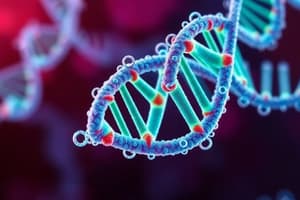Podcast
Questions and Answers
Which process involves the movement of water molecules across a semipermeable membrane from an area of high concentration to an area of lower concentration?
Which process involves the movement of water molecules across a semipermeable membrane from an area of high concentration to an area of lower concentration?
- Apoptosis
- Osmosis (correct)
- Mutation
- Diffusion
All mutations lead to cancer.
All mutations lead to cancer.
False (B)
What term describes the process of 'cellular suicide' during cell division when DNA damage is irreparable?
What term describes the process of 'cellular suicide' during cell division when DNA damage is irreparable?
apoptosis
A substance that is known to be capable of causing cancer is called a ______.
A substance that is known to be capable of causing cancer is called a ______.
Which of the following best describes a benign tumor?
Which of the following best describes a benign tumor?
What is characteristic of malignant tumors?
What is characteristic of malignant tumors?
When normal cells are in contact with other cells, they usually stop dividing. This property is known as ______ inhibition.
When normal cells are in contact with other cells, they usually stop dividing. This property is known as ______ inhibition.
Match the following terms with their definitions:
Match the following terms with their definitions:
What are the key assessments performed at the G1 checkpoint?
What are the key assessments performed at the G1 checkpoint?
The spindle checkpoint occurs during the G2 phase.
The spindle checkpoint occurs during the G2 phase.
Cancer cells lose ________, which is one of their key characteristics.
Cancer cells lose ________, which is one of their key characteristics.
What is the primary purpose of the G2 checkpoint?
What is the primary purpose of the G2 checkpoint?
Which of the following describes a characteristic of cancer cells?
Which of the following describes a characteristic of cancer cells?
Match the following cancer treatments with their method of action:
Match the following cancer treatments with their method of action:
Metastasis refers to cancer cells becoming specialized.
Metastasis refers to cancer cells becoming specialized.
Why might chemotherapy lead to hair loss?
Why might chemotherapy lead to hair loss?
What characteristic of cancer cells makes them difficult to treat?
What characteristic of cancer cells makes them difficult to treat?
All cells come from pre-existing cells.
All cells come from pre-existing cells.
What does the acronym MRS GREN stand for?
What does the acronym MRS GREN stand for?
The ______ controls cellular activities and contains DNA.
The ______ controls cellular activities and contains DNA.
Match the following organelles with their primary function:
Match the following organelles with their primary function:
Which of these is only found in plant cells?
Which of these is only found in plant cells?
The endoplasmic reticulum (ER) is responsible for creating proteins.
The endoplasmic reticulum (ER) is responsible for creating proteins.
What is the main function of the cell membrane?
What is the main function of the cell membrane?
The process by which cells create energy is called ______.
The process by which cells create energy is called ______.
Which of the following is the correct order of the living thing hierarchy, from smallest to largest?
Which of the following is the correct order of the living thing hierarchy, from smallest to largest?
Flashcards
Sensitivity
Sensitivity
The ability of an organism to detect and respond to changes in its environment.
Growth
Growth
The ability of an organism to increase in size.
Reproduction
Reproduction
The ability of an organism to pass on genetic information to offspring.
Excretion
Excretion
Signup and view all the flashcards
Nutrition
Nutrition
Signup and view all the flashcards
Death
Death
Signup and view all the flashcards
Organ
Organ
Signup and view all the flashcards
Cell
Cell
Signup and view all the flashcards
Organelles
Organelles
Signup and view all the flashcards
What is Cell Theory?
What is Cell Theory?
Signup and view all the flashcards
Diffusion
Diffusion
Signup and view all the flashcards
Osmosis
Osmosis
Signup and view all the flashcards
Apoptosis
Apoptosis
Signup and view all the flashcards
G0 - resting state
G0 - resting state
Signup and view all the flashcards
Mutation
Mutation
Signup and view all the flashcards
Carcinogen
Carcinogen
Signup and view all the flashcards
Benign
Benign
Signup and view all the flashcards
Malignant
Malignant
Signup and view all the flashcards
G1 checkpoint
G1 checkpoint
Signup and view all the flashcards
G2 checkpoint
G2 checkpoint
Signup and view all the flashcards
Spindle checkpoint (M checkpoint)
Spindle checkpoint (M checkpoint)
Signup and view all the flashcards
Loss of contact inhibition
Loss of contact inhibition
Signup and view all the flashcards
Metastasis
Metastasis
Signup and view all the flashcards
Lack of Specialization
Lack of Specialization
Signup and view all the flashcards
Chemotherapy
Chemotherapy
Signup and view all the flashcards
Radiation therapy
Radiation therapy
Signup and view all the flashcards
Study Notes
Diffusion
- Movement of molecules from high concentration to low concentration
- Can occur through a semipermeable membrane, but not always
Osmosis
- Movement of water molecules from high water concentration to low water concentration
- Always through a semipermeable membrane
- Equilibrium is reached when the concentration of water is the same on both sides
Apoptosis
- "Cellular suicide"
- A cell kills itself during the G2 checkpoint of cell division
- If DNA damage is irreparable
- Cell breaks down and its fragments are recycled or destroyed
Go-resting State
- If a cell doesn't pass the G1 checkpoint, it can enter a resting state
- Waits for conditions suitable for replication
Mutation
- A permanent change in a cell's DNA
- All cancers begin with a mutation that affects cell response to division signals
- Mutations can be passed to other cells during mitosis, but not all mutations cause cancer
Carcinogen
- Substance, organism, or agent that can cause cancer
- Examples include UV light, radiation, and chemicals
Benign Tumour
- Tumour that is not cancerous
- Not invasive and does not spread to other parts of the body
- Cell division is controlled and moderate
- Relatively harmless, except when on the brain
Malignant Tumour
- Cancerous tumour
- Cell division is uncontrolled and rapid
- These cells spend little time in interphase
- Can spread and damage surrounding cells
- Can interfere with other cell functions
Contact Inhibition
- Normal cells are in contact with other cells and stick together
- When cells get too close, they stop dividing (contact inhibition)
- Cancer cells lose this ability and continue dividing even when crowded
Metastasis
- Cancer cells do not stick well to normal cells
- Cancer cells can spread by moving and dividing in other parts of the body
- Difficult to treat as the cancer spreads rapidly
MRS GREND
- Movement, Respiration, Sensitivity, Growth, Reproduction, Excretion, Nutrition, Death
- Characteristics of living things
Cell Theory
- All organisms are composed of one or more cells
- The cell is the basic unit of structure and organization in living things
- All cells come from pre-existing cells
Organelle Structures and Functions
- Nucleus: Controls cell activities, holds DNA, the nucleolus makes ribosomes
- Mitochondria: Makes energy for the cell through cellular respiration
- Golgi apparatus: Processes and packages proteins
- Endoplasmic Reticulum (Rough & Smooth): Transports proteins and fats
- Ribosomes: Create proteins
- Lysosomes: Break down bacteria and waste
- Vacuole: Stores water, food, and waste
- Cell wall: Provides support and protection (plant cells only)
- Chloroplast: Site of photosynthesis (plant cells only)
Animal vs Plant Cells
- Animal cells: Centrioles, rounded shape, smaller numerous vacuoles cell membrane
- Plant cells: Chloroplast, geometric shape, cell wall + cell membrane, 1-2 large vacuoles
Prokaryotic vs Eukaryotic Cells
- Prokaryotic cells: unicellular, no membrane-bound organelles, simple functions
- Eukaryotic cells: unicellular or multicellular, membrane-bound organelles, complex functions
Cell Division Reasons
- Reproduction: Asexual, genetic information passed to offspring
- Growth: Increasing number of cells
- Repair: Replacing damaged cells
Cell Cycle
- Cell growth
- DNA replication
- Interphase, mitosis, cytokinesis
- Stages: G1, S, G2, Mitosis (prophase, metaphase, anaphase, telophase), cytokinesis
Cell Division Checkpoints
- G1 checkpoint: Decides if the cell should divide
- G2 checkpoint: Checks for complete DNA replication
- M checkpoint: Checks spindle fiber attachment
Cancer Cell Characteristics
- Lack of contact inhibition
- Metastasis
- Abnormal structure
- Lack of specialization
Cancer Treatment Methods
- Chemotherapy: Drugs that stop cancer cell division
- Radiation therapy: Damage DNA of cancer cells
- Biophotonics: Uses light to detect and treat cancer
- Immunotherapy: Boosts the immune system to fight cancer
Studying That Suits You
Use AI to generate personalized quizzes and flashcards to suit your learning preferences.





